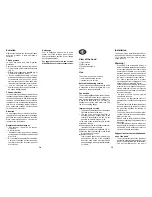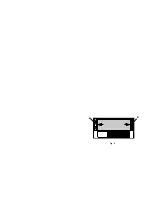
Entretien
Débrancher l’appareil du réseau électrique
avant de procéder à toute opération d
entretien.
Filtre à graisse
La hotte est munie d'un filtre à graisse
métallique.
Pour nettoyer le filtre, procéder comme suit:
— Ouvrir la grille en tournant les boutons A
(fig. 3).
— Déformer les supports en plastic B (fig.6)
et enlever le panneau filtrant.
— En cas d'utilisation normale, le filtre à
graisse doit être lavé une fois par mois au
lave-vaisselle ou bien avec un peu de
savon dissout dans de l'eau tiède; bien
laisser sécher le filtre avant de le remonter.
— Lors du nettoyage des filtres, laver
également la grille avec de l'eau tiède et
du savon biodégradable.
Filtre au charbon
Le filtre au charbon actif a pour but d’éliminer
les odeurs qui se forment pendant la cuisson.
Lors d’un usage normal, il doit être remplacé
tous les 4 en commandant un neuf filtre au
fournisseur; il ne peut absolument pas être
lavé. Pour le démontage, tourner le filtre en
sens antihoraire jusqu'àu déclenchement
hors de son emplacement.
Attention
Le non respect des normes d’entretien de
l’appareiI et de remplacement et nettoyage
des filtres comporte des risques d’incendie.
Nous recommandons donc vivement de
respecter ces instructions.
Remplacement des lampes
— Débrancher l’appareil du réseau
électrique.
— Enlever la grille
— Remplacer la lampe grillée en utilisant
exclusivement des lampes ovales de 40W
max (E14).
— Si l’on désire faire appel au Service Après
Vente car l’éclairage ne fonctionne pas,
contrôler avant tout si les lampes sont
bien vissées.
Nettoyage
Pour le nettoyage extérieur de la hotte,
utiliser un chiffon imbibé d’alcool ou des
détergents liquides neutres. Eviter l’usage
de tout produit abrasif.
Cet appareil est conforme aux normes
87/308 EWG concernant les antiparasites.
View of the hood
1) Light switch
2) Motor switch
3) Work surface lamp
4) Grill
Use
The hood may be used in 2 ways:
— external exhausting version
— internal recycle version
External exhausting version
The air is conveyed out through a pipe which
is connected to the outlet hole A (fig. 1) by
means of a coupling flange B.
Connection
The coupling ring B has a diameter of 120mm.
The air must be vented out by means of a
pipe with an internal diameter of 120mm.
A non-return fume valve (120 mm diam.) is
available on request, at an extra cost. This
fits in the coupling flange.
Internal recycle version
—The air is purified through an active carbon
filter and returned to the room.
—The use of an active carbon filter is
necessary when an exhaust pipe to the
exterior is not available, or when it is not
possible to install this type of pipe.
In the case of the internal recycle version
proceed as follows:
a) Request an active carbon filter suitable for
this model from your supplier.
b) Remove the grill by turning knob A (fig. 3).
c) Place the filter on its seat (fig. 4) and rotate
in clockwise until it stops.
d) Replace the grill.
In this version vapour and fumes will be
exhausted on the top of the cupboard
where the hood will be mounted through
an exhaust pipe with an internal diameter
of 120 mm.
Installation
The hood must be installed at least 65 cm
from the hob of electric cookers and at least
75 cm from the hob in the case of gas or
mixed cookers.
Warning!
— If the hood is run at the same time as a
burner or fireplace that depend on ambient
air (for example gas, Diesel, coal or wood
heaters, water heaters, etc.) be careful,
because the hood, when it exhausts the
air, removes the ambient air required by
the burner or fireplace for combustion.
— For secure operation and to prevent
discharged gas from coming back in, the
vacuum must not exceed 0,04 mbr.
This may be done by making sure the air
inlet into the room passes through non-
closing openings such as air recycling
wall boxes, doors, windows or with other
technical measures.
— No food must be cooked flambé
underneath the hood.
The use of an unprotected flame is
dangerous for the filters and could cause
fires.
Therefore, never use an open flame under
the hood. When frying foods, never leave
the pan alone because the cooking oil
could flare up.
— The hood must not be connected to fuel
exhaust flues (boilers, heating systems,
water heaters, etc.).
— Please, keep to the provisions of official
directives regarding the question of fume
discharge.
— The manufacturers refuse to accept any
responsibility for damage to the hood or
its catching on fire because of failure to
observe the above instructions.
Suggestions for the installation and
use of the hood
— The horizontal sections of the pipe must
be slanted slightly upwards (about 10%)
to ensure an easy flow of the air outwards.
— The best performance of the unit is
14
15
GB
Summary of Contents for JDL5320W
Page 3: ...Fig 3 3 4 A A A 1 2 ...
Page 4: ...Fig 3 B B ...






















